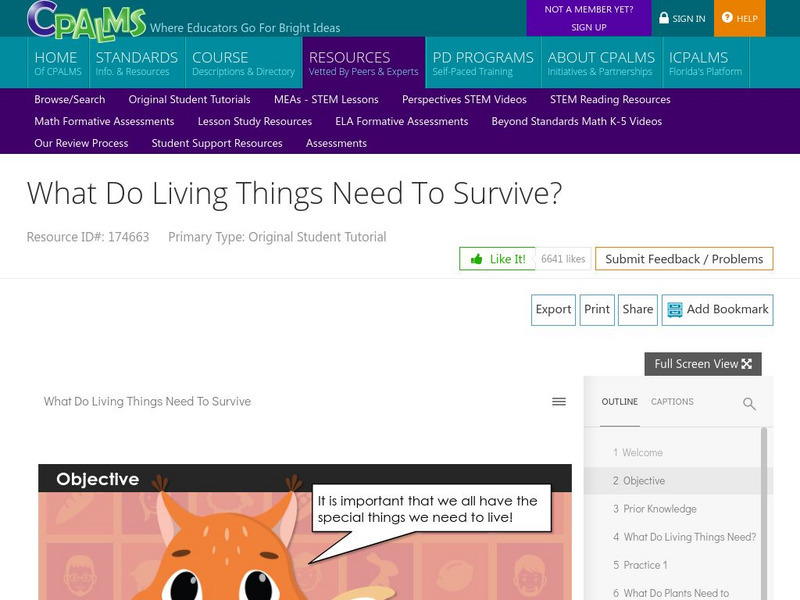Curated Video
Basic Needs of Living Things: Part 2
Dr. Algae shows examples of how different living things receive the food, air, and water that they need to survive.
Curated Video
Basic Needs of Living Things: Part 1
Dr. Algae explains why all living things need food, air, and water to survive.
TED Talks
TED: Language shouldn't be a barrier to climate action | Sophia Kianni
Most scientific literature is written only in English, creating an alarming knowledge gap for the 75 percent of the world who don't speak it. That's a big problem for climate change -- because it's hard to take action on something you...
Visual Learning Systems
What Do Living Things Need?: Video Quiz
All living things have basic needs that must be met in order to survive. This colorful, easy-to-understand program addresses the basic needs of organisms. By considering specific plants and animals, we see how living things need food,...
Visual Learning Systems
What Do Living Things Need?: Introduction
All living things have basic needs that must be met in order to survive. This colorful, easy-to-understand program addresses the basic needs of organisms. By considering specific plants and animals, we see how living things need food,...
Visual Learning Systems
What Do Living Things Need?: Food
All living things have basic needs that must be met in order to survive. This colorful, easy-to-understand program addresses the basic needs of organisms. By considering specific plants and animals, we see how living things need food,...
FuseSchool
Intro To Cells: Animals & Plants
All living organisms are made up of cells - they are the basic building blocks of life. There are two important categories of cells: plant cells and animal cells. In this video we look at animal cells in more detail. Animal cells are the...
Curated Video
Am I Alive?
Dr. Forrester teaches about the characteristics of living things. She explains the basic needs of living things: food, water, and shelter.
Visual Learning Systems
What Do Living Things Need?: a Place to Live
All living things have basic needs that must be met in order to survive. This colorful, easy-to-understand program addresses the basic needs of organisms. By considering specific plants and animals, we see how living things need food,...
Visual Learning Systems
What Do Living Things Need?: Water
All living things have basic needs that must be met in order to survive. This colorful, easy-to-understand program addresses the basic needs of organisms. By considering specific plants and animals, we see how living things need food,...
Visual Learning Systems
What Do Living Things Need?: Air
All living things have basic needs that must be met in order to survive. This colorful, easy-to-understand program addresses the basic needs of organisms. By considering specific plants and animals, we see how living things need food,...
SciShow
3 New Missions Just Left for Mars! | SciShow News
A launch window that only happens every 26 months means it’s the perfect time to head to Mars! The United Arab Emirates, China, and the United States all took advantage of this excellent timing.
Curated Video
Aerobic and Anaerobic Respiration: Energy Production in Living Organisms
This video explains the concept of cellular respiration and the differences between aerobic and anaerobic respiration. It explains the word and chemical symbol equations for aerobic and anaerobic respiration, as well as the differences...
Curated Video
Intro To Cells: Animals & Plants | Cells | Biology | FuseSchool
All living organisms are made up of cells - they are the basic building blocks of life. There are two important categories of cells: plant cells and animal cells. In this video we look at animal cells in more detail. Animal cells are the...
Visual Learning Systems
Nutrition and Nutrients
The video discusses the basic needs of living organisms such as plants, animals, and humans. It highlights the importance of air, water, sunlight, and nutrients for survival. The focus then shifts to human nutrition and the various...
Ancient Lights Media
Plants: The Internal Structure of Dicot Stems
Plants: The Internal Structure of Dicot Stems: This clip describes the roles of important internal structures present in the stems of Dicot plants.
Curated Video
Seven Life Processes | Physiology | Biology | FuseSchool
Seven Life Processes | Physiology | Biology | FuseSchool Earth is truly staggering they are estimated to be between 5 to 10 million different living species on the earth and that's excluding all the bacteria as they are really hard to...
Curated Video
What Is Carbon Neutral and Biofuels | Environmental Chemistry | Chemistry | FuseSchool
Learn the basics about carbon neutral and biofuels, as a part of environmental chemistry. Coal, oil, natural gas, shale gas and gas from fracking are fossil fuels formed hundreds of millions of years ago from living things that got...
Red Rock Films
Ecosystem Activator: Temperate Forests. Age 7 - 10.
Temperate forests of deciduous and coniferous trees. Animals and their seasonal interactions with the trees and forest biome. Engaging Animal Behavior within the ecosystem. How to protect this ecosystem.
CPALMS
Cpalms: What Do Living Things Need to Survive?
Explore the needs of living things, including plants and animals, as you complete this interactive tutorial.
PBS
Pbs Learning Media: Habitat and Diet in Racehorse Development
This animated segment from KET's Electronic Field Trip to a Horse Farm demonstrates one of the ways calcium, a naturally occurring mineral derived from limestone, enters a horse's diet to give it an advantage in bone strength. [1:09]





